Submit Samples
Samples may be dropped off or mailed to MSU Plant and Pest Diagnostics. Please avoid shipping samples on Fridays, as packages are not delivered to campus on weekends.
When submitting samples, we encourage clients to email digital images to accompany the physical samples. Images can be sent to pestid@msu.edu. Please note that images submitted may be used by diagnosticians for educational purposes, but they will not include any identifying information.
Ship/Deliver Samples Directly
MSU Plant & Pest Diagnostics
578 Wilson Road
East Lansing, MI 48824
Tips for Sample Submission
- Plant Health Analyses
- Crop-Specific Details
- Weed / Plant Samples
- Nematode Samples
- Insect / Arthropod Samples
- Herbicide Resistance
1. Plant Health Analyses
Collecting Plant Samples
It is best to send entire plants, although we recognize this is not always possible. Plants with root and crown rot diseases cannot be properly diagnosed unless root and crown tissue are submitted. Dig, rather than pull, plants from the ground to preserve the root integrity. Submit plants with symptoms that are in varying stages of decline. Avoid sending samples that contain only dead plants. Growers with larger crops/plantings are encouraged to submit multiple plants to ensure there is enough tissue for analyses by several diagnosticians with multiple methods. See below for instructions specific to various plant types.
Packaging Plant Samples
Do not add wet paper towels or other sources of moisture when packaging samples. Plant material should be wrapped in dry newspaper and then placed in a plastic bag to preserve the integrity of the sample. When root tissue is included, wrap the root balls in plastic to prevent the soil from coming in contact with the foliage. Large samples (ex., tree branches) can be cut into sections for easier packaging. Do not ship any type of sample that will leak contents from the packaging (ex., severely rotted fruit, loose soil, etc.).
Almost all samples should be shipped in a box, rather than an envelope. Leaves and stems that are pressed and mailed in envelopes do not arrive in good condition.
Include a completed copy of the General Sample Submission Form, and put the form in a separate re-sealable bag to prevent it from getting damp or soiled.
Shipping Plant Samples
Avoid shipping samples on Fridays; samples are not delivered to campus on weekends and may not arrive in the lab in good condition the following week. All major shipping companies deliver to the lab or campus. The shipping address is included at the top of the submittal form. Shipping containers/materials are not returned to clients unless previous special arrangements are made.
Images of Plant Samples
Clear images of plants and their symptoms are highly valuable to our diagnostic staff. Please email images to the lab, including the following:
- Close-up shots of the symptoms of concern.
- Full-view images of the entire plant or tree and its surroundings.
In your email, include:
- Your name and contact information.
- The date the accompanying physical sample was sent or will be sent.
Please ensure images are in focus, as blurry images cannot be used. We are unable to enhance the focus of submitted images. Images sent to the lab may be used by staff for educational purposes without including identifying information.
Note: We reserve the right to limit identifications based on the current sample volume.
Out-of-State Clients
Clients submitting samples that are collected outside of Michigan must follow some additional packaging protocols. Samples must be double bagged and sealed (ex., two Ziplock freezer bags). Place the sealed bags in a sturdy shipping container. Our lab has USDA APHIS permits in place to accept samples from the continental U.S.
Please note that the base submission fee is increased for out-of-state clients.
If you have any doubt about what to collect or how to collect a good sample, please contact the lab at (517) 432-0988 or via email at pestid@msu.edu.
2. Crop-Specific Details
Herbaceous Plants
When possible, send entire plants, including roots and some soil. Roots and soil should be in a plastic bag tied off at the soil line to prevent soil from touching foliage. This plant material degrades fairly quickly; as a result, plants should be dropped off in person or sent with overnight or priority shipping.
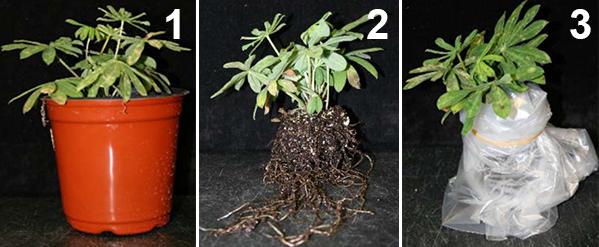
Read more about how to mail herbaceous plants for disease and pest analysis.
Plugs/Seedlings
It is tricky to get plugs submitted to the lab in good condition. Leave the plugs in the tray for shipping purposes. Entire trays are not required; a section of the tray can be cut and shipped. Submit a minimum of 12 plugs. Wrap the plug sheet in newspaper or add packing material that will prevent plugs from being dislodged from the tray. This plant material degrades fairly quickly; as a result, plants should be dropped off in person or sent with overnight shipping.
Tree Samples with Leaf Spots
Select affected foliage, but wherever possible, leave it attached to the branch. Send several affected samples representing the early and moderate stages of symptom progression. Although the sample may seem flat enough to package and ship in an envelope, please package and ship it in a box. This protects the sample during the shipping process.
Trees with Suspected Vascular Wilt diseases, including Verticillium Wilt, Dutch Elm Disease, Oak Wilt
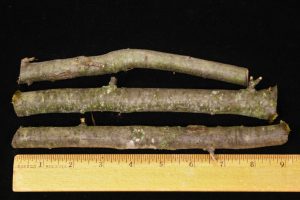
Select branches that are partially wilted, with symptomatic leaves progressing from the tip of branches inward to the trunk. Be sure that branches are not totally wilted, dry, or dead. Select samples from up to three symptomatic branches per single tree. Branch samples should be at least 1 inch in diameter, cut into 6-8 inch lengths, and placed in large re-sealable plastic bags. Keep samples cool during sampling, shipping, and storage, but do not freeze. Ship samples overnight mail (no later than Thursday) or deliver in person to the laboratory.
- Read our general guidelines on submitting tree samples for wilt diagnosis.
- Oak wilt clients, please read "The best sampling procedures for accurate oak wilt testing".
Vegetables
These samples may include plants, fruit, or both. If fruit rot is a concern, select fruit that is in the initial stages of symptom development. Be sure to package in leak-proof containers (ex, sealable plastic bags). Delivery personnel may not deliver packages that are leaking.
Grapes
These samples may include fresh leaves with attached petioles or lignified plant material (canes, cordons, trunk, etc.). The type of plant material to submit for testing depends on the case; please contact the laboratory.
Hops
Hop rhizomes, shoots, leaves, and cones can be evaluated for different diseases. Read more about submitting hop samples for virus and viroid testing.
Blueberries
Read more about submitting blueberry samples for problem diagnosis.
Residential Turf
Include a square of turf from the margin of the diseased area so that both healthy and diseased turf is included. Minimally, the turf square should be 6 inches x 6 inches. An intact layer of soil should remain on the root system. Wrap samples in newspaper and pack in a box for shipment. Do not add moisture to the turf prior to shipment. Provide a detailed description of cultural practices (irrigation, fertilization, pesticide application, etc.) and images of the symptoms in the lawn with the sample.
Please note that MSU Plant & Pest Diagnostics does not perform health analyses of golf course turf.
3. Weed / Plant Samples
Herbaceous Plant Identification
Submit a representative sample containing vegetative structures, leaves, and flowers. Plants may be pressed flat between papers or cardboard to prevent leaf crinkling. For best results, plants should be submitted immediately after taking the sample.
Woody Plant Identification
Submit a large section of the terminal end of the stem or branch. Where possible, include any flower or fruiting structures. Leaves may be pressed flat between papers or cardboard to prevent leaf crinkling. Woody plants may be wrapped in plastic to retain moisture.
Hay Examination for Toxic Plants (We do not offer nutritional analysis of hay)
Hay flakes can be packed in a cardboard box and dropped off or shipped to the lab. Include any plant material that looks different in color or texture. Please contact Erin Hill - hiller12@msu.edu or Angie Tenney - millera3@msu.edu prior to shipping to determine the appropriate sample size. We are not able to examine an entire bale of hay.
Include a completed copy of the General Sample Submission Form.
4. Nematode Samples
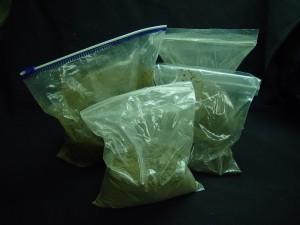
Always store nematode samples in plastic bags or other containers that retain moisture. Please do not use paper bags for soil samples. Submit a pint to a quart of soil per sample. If nematode samples need to be stored before submission, try to keep them cool. Include a completed copy of our Nematode Analysis Submission Form along with the sample.
Problem Diagnosis
Collect soil and roots (or foliage) from the margins of diseased areas. Submit samples of diseased and healthy plants for comparison purposes.
Problem Avoidance
Collect soil and roots (if available) by walking a zigzag or w-shaped pattern. Try to collect 10-25 subsamples using a soil probe, trowel, or shovel. One sample per field is adequate unless you can identify problem areas such as sandy locations, along ditches or river banks where flooding occurs, etc., then two or more samples are recommended.
For more information on sampling methodologies, read Detecting and Avoiding Nematode Problems.
Garlic Bloat Nematode Sampling Protocol
To detect bloat nematode, Ditylenchus dipsaci, we require 10 garlic bulbs per variety.
Pinewood Nematode Sampling Protocol
To confirm a diagnosis of pine wilt, it is necessary to collect wood and submit it to Plant & Pest Diagnostics for pinewood nematode extraction and identification. Branches should be at least 2-3 inches in diameter and 4-12 inches long. It is best if this segment is cut from a branch exhibiting early symptoms of yellowing of the needles. Cross sections or wedges of the lower trunk can also be submitted if the tree has already been cut down. Pinewood nematodes are found in the resin canals of the tree, so they will not be recovered from the bark, roots, or terminal twigs, including needles.
5. Insect / Arthropod Samples
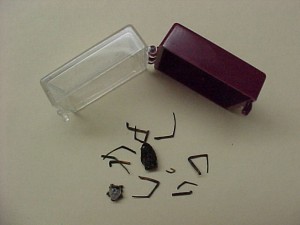
Identification of insects or other arthropods requires specimens to be undamaged upon arrival in the lab.
Specimens mailed in envelopes will be crushed by the mail machines. Please kill and ship specimens in a hard sided, leak-proof container, just enough rubbing alcohol or white vinegar to cover the specimens (shown below). Include multiple specimens whenever possible.
Include a completed copy of the General Sample Submission Form.
Ants / Other Adult Arthropods
Ant specimens should only include worker ants (i.e., those without wings). Submit ants and all other hard-bodied specimens in rubbing alcohol or vinegar.
Moths / Butterflies
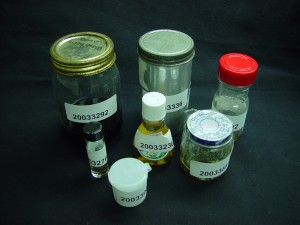
Place specimens in the freezer for an hour to kill them and gently pack them in a small box or vial with tissue paper.
Larvae (caterpillar, grub, maggot, etc.)
Larvae can be placed in a vial or other leak-proof container with rubbing alcohol or vinegar. Please take a top down picture of the specimen before putting it in the vial and email it to MSUBugHelp@msu.edu. Specimens in alcohol lose coloration quickly, the picture will allow us to use the original coloration and markings which can help in identification.
Images of Insects, Spiders, Ticks, and other Arthropods
We can often identify specimens from images, provided they are well-lit and in focus. Clear images of insects, spiders, ticks, and other arthropods can be emailed to MSUBugHelp@msu.edu for identification. Please choose the highest resolution pictures of your specimen. If an image appears dark or blurry to you, it will appear dark and blurry to us. We are unable to enhance the quality of images.
- If you are not able to capture a focused image of the specimen, please mail the specimen to the lab for identification.
- If your specimen is very tiny a camera/phone may not be able to capture the tiny structure needed for identification and you may be asked to mail the specimen to the lab for identification.
Images submitted to the lab may be used by lab staff for educational purposes without including identifying information.
Note: We reserve the right to limit the number of identifications via digital images based on the current sample volume.
6. Herbicide Resistance
Weed seed is required to conduct a whole plant bioassay in the greenhouse to screen for herbicide resistance. Mature, high-quality seed or seedheads should be collected from suspicious plants in the late summer or fall; ideally, pooled samples with seed/seedheads from five or more plants will ensure adequate seed quantity. For species-specific information on correctly identifying mature seed and collection tips, please reference Tips for Collecting Weed Seeds. Place samples in a sealed paper bag. Do not submit samples in a plastic bag, as mold and decay will compromise the sample. Screens will be designed by herbicide site of action (e.g., EPSP synthase inhibitor, ALS inhibitors, Photosynthesis inhibitors, etc.). Screening results are generally available 2-3 months after submission to allow for seed cleaning, dormancy-breaking measures, greenhouse growth, herbicide application, and evaluation.
Include a completed copy of the Herbicide Resistance Screening Submission Form.



 Print
Print Email
Email